This blog is part of the interactive media resources of my-mu.com and is used to discuss and investigate the theories of James Churchward and the Lost Continent of Mu.
Sunday, October 05, 2008
October 2008 Update
The podcast and transcript can be downloaded from the podcasts page at:
http://www.my-mu.com/podcasts/
or available from youtube:
Sunday, September 21, 2008
References to the 8th Century Uyghur Khaganate
Sinor, Peter, Editor; The Cambridge History of Early Inner Asia; Cambridge University Press; 1994; Chapter 12 pages 317-342.
Barthold, W.; Turkestan Down to the Mongol Invasion; Munishiram Manoharlil Publishers Pvt Ltd; 1992
Grousset, Rene; The Empire of the Steppes a History of Central Asia; Rutgers University Press; 1997
Thursday, September 04, 2008
Bookstore Remodel
EBook #1
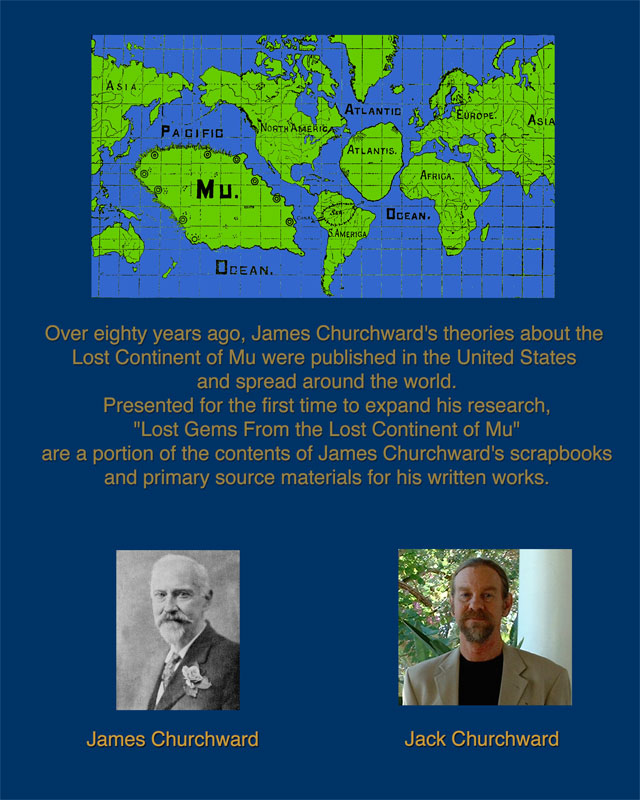
Lost Gems of The Lost Continent of Mu
Reviews and Correspondence from James Churchward's Scrapbooks
A 70 page E-Book with the complete contents of James' scrapbook entitled "Letters and Reviews" and some pages included from "Clippings."
Preface by Jack Churchward
EBook #2
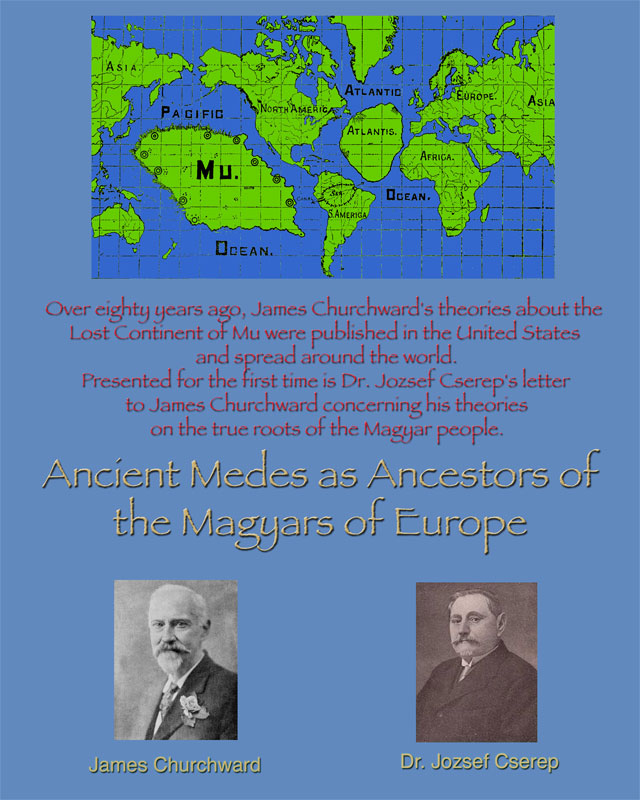
Ancient Medes as Ancestors of the Magyars of Europe
Translation of letter to James Churchward from Dr. Joseph Cserep of the University of Budapest, Hungary. (March 1929)
Presented for the first time, this 24 page letter has been scanned and reproduced with the original written comments included from James Churchward.
EBook #3
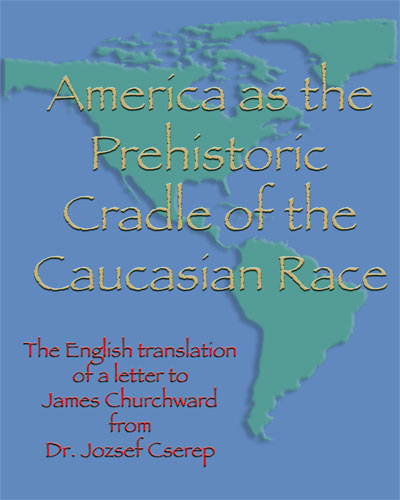
America as the Prehistoric Cradle of the Caucasian Race
Translation of letter to James Churchward from Dr. Joseph Cserep of the University of Budapest, Hungary. (August 1928)
Presented for the first time, this 19 page letter has been scanned and reproduced with the original written comments included from James Churchward.
EBooks on CD
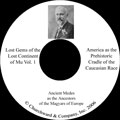
All three EBooks listed above in PDF format on CD shipped to the address you specify for a total of $29.95 ($24.95 + $5 Shipping)
Keep a permanent copy of these EBooks in your collection for only $29.95. No need to download another copy if your hard drive crashes, you will have your own permanent copy. Each book suitable for printing.
Satisfaction guaranteed.
Allow two (2) weeks for delivery.
Tuesday, September 02, 2008
Update on Research for Great Uighur Empire Aug 08
Please listen to the latest podcast for the update on our research.
Podcast Video(iPod format)
Podcast Transcript
or catch the YouTube version:
Jack Churchward
Clearwater, Florida
Sunday, July 13, 2008
James Churchward, Engineer
 George Jackson Churchward |  James Churchward |  Albert Churchward |
Beginning in 1889, as documented from US Patent Office records, James Churchward started to file for patents on his inventions. As covered in a previous blog entry, James was affiliated with both the Bangor & Aroostook Railroad and the New York Central and Hudson River Railroad Companies, however he was known for his writing and outdoor skills in the performance of those duties.
According to the records from the US Patent Office that I have viewed, James had 31 patents. The first eight are applicable to his work on the railroad. In addition to his two books on the subject of hunting and fishing, James was also a salesman as mentioned in his 1936 biography "My Friend Churchey" by Percy Tate Griffith. It does not seem to be a stretch of the imagination that while on board, his analytical mind saw improvements and acted upon them. This viewpoint is also supported by evidence that James presented a paper, "And Rail Fastenings" to the Society of Railway Superintendents prior to October 1890 [Descriptive index of current engineering literature, Vol 1; Board of managers of the Association of Engineering societies; Chicago, 1892; page 299].
 |  |
In the obituary of his younger brother Albert, recorded in the London based "The Freemason"[September 12, 1925], mention is made of his inventions:
"Bro. Churchward was the inventor of a hygienic bicycle saddle, improved cycle pedals, and a new process of hardening and toughening steel and armour plates."
Alexander Churchward, James' son, patented 56 new inventions, including "Electrical lighting and battery charge system for vehicles"(1915), "Starting mechanism for internal combustion engines"(1920), and Electric arc welding"(1922). My father, Jack Churchward (and Alex's son) had seventeen inventions, including different welding processes, welding electrode holders, and boat anchors. I remember the boat anchors because from time to time as a kid, I would help out on the line at his shop, cleaning the slag from the welds. I have not been awarded any patents yet (but I'm hopeful).
Another of James' cousins was also an inventor by the name of George Jackson Churchward, Chief Mechanical Engineer of the Great Western Railway in the UK from 1902 to 1922.
I didn't recount the list of inventors with the name Churchward just to toot the family horn. James Churchward, although known as the author of several books about the Lost Continent of Mu, was also an inventor. This posting isn't meant to be an exhaustive study of his inventions (his patents are listed here,) only to indicate to interested readers that my great-grandfather was more than just some spiritualist writer of the early twentieth century.
After his Railroad inventions, all of which were patented using a Brooklyn address, James started to work on Steel. Steel processes and alloys were patented seven years after his railroad inventions. His steel patents were awarded to him starting when he was 55 years old with an address in Manhattan. In the years 1906-1907, he was awarded eleven more patents and three more in 1908. Another piece of the puzzle falls into place when you see the following newspaper clippings:
 |  |
I have also read about Churchward International Steel in James' biography by Percy Tate Griffith entitled "My Friend Churchey." After reading about it, I went online and made enquiries to the Delaware Department of State to learn more about who the stock-holders were and when the corporation existed, but my letter must have disappeared into that black hole of bureaucracy. I'll be sending another letter in the future to clear up any confusion.
| Churchward International Steel Court Transcripts | |||
|---|---|---|---|
 |  |  |  |
| September 1915 9 Pages 676K | October 1915 9 Pages 648K | May 1917 196 Pages 10.5 M | March 1920 81 Pages 5 M |
Even with the pending lawsuit, James still wasn't idle, in 1911, he filed for five more patents on alloys of Steel. As a result of the litigation, James was awarded a large settlement and four years later (1914), his common law wife, Louise (Haier) Churchward purchased 7.22 acres of land in Lakeville, Connecticut. One would imagine that since his un-divorced wife (and my great-grandmother,) Mary Julia, still lived in Boston, he might care to keep the property out of his name. The details of that are best suited for another blog at another time.
Now in 1916, James was 65 years old and had twenty-seven patents under his belt over the past 27 years. For most people that have that type of record, it would be considered a career, but James wasn't done. One notable point is that until 1917, James accorded himself as "a subject of the King of England" in his patent applications. Only in his last four patent applications would he describe himself as a citizen of the United States. At the age of sixty-six, he filed the last four application, the last one being awarded in 1922.
So, because of his career as an inventor and engineer (and the infringement on his patents), he was able to undertake/continue his study of the Lost Continent of Mu, probably starting sometime after 1917, when he finished his last patents. Over the next nine years he was able to gather his notes, research and explore until he released his first (non-hunting/fishing) book entitled "Lost Continent of Mu The Motherland of Man" in 1926 at the age of seventy-five.
These are some facts about the work of James Churchward, engineer & inventor. Another reason to mention the other Churchwards was to provide for full disclosure. The careful reader will notice that George Jackson Churchward worked on railroads as a mechanical engineer and although he was younger than James, it is possible that they knew each other and that James simply helped himself to a little intellectual property and applied for the patents in the United States. As noted in the clipping about Albert his brother, he was also an inventor and patented armour plating in the UK. Some might say that James simply spent those 28 years as an inventor because he helped himself to other people's ideas. While I think I have shown that at least some of his offspring continued inventing (and thereby implying that he had the 'invention' gene), there is other clear evidence to dispel those accusations. Since GJ Churchward worked on locomotives and James appears to have settled on improvements in the tracks and there are references to the James' papers on those improvements, I believe that such rumors can be silenced. Also, there is no evidence that clearly indicates he had any contact with G.J. Churchward, or that James copied his brother's work. As far as their theories about early man (Albert was a prolific lecturer and author), James and Albert were miles apart, but that again is a subject for another blog entry.
Jack Churchward
Clearwater, Florida
Saturday, May 31, 2008
James Churchward & "The Christ Conspiracy" Part 2
The reason for this assertion was that wikipedia, in the article for James Churchward, has the following as part of the entry:
"He is also a source of information for Acharya S, in her two books, The Christ Conspiracy: The Greatest Story Ever Sold and Suns of God: Krishna, Buddha, and Christ Unveiled."As I researched further, I discovered two examples of what I considered to be intellectual dishonesty in the use of James Churchward's quotes. The quotations were taken out of context and if the entire passage had been included from James, the meaning would be changed significantly, enough to contradict Ms. Murdock.
Subsequently, I wrote the podcast and released it in November 2007. The nasty emails started almost immediately and I shut down the comments section of my blog and set the comments on moderate for YouTube. Everything I wrote was true when it was written. My corporate firewall had categorized her website as 'hate speech' but that has since changed.
This entire affair culminated in YouTube removing the video of the podcast due to 'inappropriate content.' For six months, it was watched by almost 800 folks, but suddenly it became inappropriate in late May 2008. It seems almost humorous for a person who claims censorship (for examples please google acharya s censorship) to use such measures against others.
I hold no ill will against Ms. Murdock or her followers and believe that I have wasted more than enough time and energy on her and her theories. I am not a quitter, but this isn't my fight.
Jack Churchward
Clearwater, Florida
Sunday, April 06, 2008
James Churchward and Space Aliens
Link to Ipod Video format - Podcast Link
In researching my great-grandfather James Churchward, I am sometimes confronted with references to his works. In some cases, the proposals supported by James words agree in principle with the world view espoused by James. In other cases, such as video games and Science Fiction adventure films, the references to his works are meant as a lark and not part of a scholarly work. Another category encompasses those academic theories that associate James' words and theories with a theory that he did not espouse. This podcast documents yet another example of the use of James Churchward's views. Today I want to address a concept that has leapt from God-knows-where to intersect my time-space continuum. This commentary addresses the links between James Churchward and Space Aliens.
It is true that James Churchward mentions flying cars‚ or vimana in his 1931 book, "Children of Mu," but these accounts were quoted from documents he had seen in India and the ancient tome known as the Ramayana. This ageless book (quoted extensively by James) was, according to legend, written by the sage Valmiki as told to him by Narada about the life story of the Hindu deity, Rama. Please note that although James mentions the aircraft being able to 'circle the earth continuously', at no juncture does he state, imply, infer or otherwise conjecture that these devices leave the atmosphere. Also, there is no mention of extra-terrestrial beings anywhere in any of his published works, neither have I found reference to extra-terrestrial beings in his newspaper clippings. Whatever James thought about Space Aliens or UFOs, he did not write about them.
Now to the event that brought this concept into my space-time continuum. A few years ago I organized a public function and was approached by what appeared to be a quiet, polite young man. He immediately wanted to know if I was 'Jack Churchward' and if I was related to James Churchward. I said yes and continued on with the plans for the function, not thinking that he had further questions. After about ten minutes, I became aware that the nice, polite young man had not left my side and was still following me around. I asked him if there was anything else he needed from me. Imagine my surprise when he, with a completely straight face, asked me if I could put him in touch with the alien mothership that was parked on the other side of the moon with all the Ascended Masters, including James. I told him that I did not know what he was talking about, but my guess is that was the wrong thing to say (or the right thing to say if I did know and was trying to hide the fact.) I gave no further thought to his question and continued working. It took about twenty minutes before I realized that my new best friend was shadowing me and would not relinquish his place behind me. His demeanor and behavior was unnerving. I asked him to please stand someplace else and when he refused, his friends thankfully intervened. It was unfortunate that he was unable to cease his fixation on my person and the location of the mothership because after a short while it became necessary to call the police. I later learned that the young man was eventually admitted to the hospital for psychological evaluation.
I imagine at this point it would be necessary to explain my positions on the young man and Space Aliens. First, had my new best friend backed off and not followed me around so closely, I would have gladly given him some time later to discuss whatever was on his mind. It was not his beliefs, only his behavior, that caused his friends to have him committed. As far as UFOs and/or Space Aliens, I have no first hand knowledge of the mothership on the other side of the moon, neither have I been contacted or personally seen anyone that convinced me that they were extraterrestrial. Having said that, the universe is a big place and it would be awful arrogant to think that humans from earth are the only intelligent species in the vastness of the space.
So how does James Churchward get linked in with the mothership and the Ascended Masters?
I never got to speak with the young man again to find out how James was connected to the mothership, so either it was a product of his deluded psyche, there was some basis in literature or a combination of the two. Therefore, what references to the mothership are out there and what about the Ascended Masters that are on board?
First, allow me to state that before I started looking into this subject, I had no idea that it was such a hot topic on the internet. I have found Galactic histories that go back millions of years, lists of the extraterrestrial beings already here on earth, and the channeled messages from the aliens. The pages where this information is presented appears to be treated seriously by those who wrote them and do not appear to be a fictional representation of any form of game. The source for much of these materials seems to be from channeling, which, unlike James' publications, is the result of the alien being speaking through a human here on earth. There does not appear to be any shortage of material involving the Ascended Masters from outer space, including their pictures and conspiracy theories, but how is James Churchward connected?
It is true that some of James' theories may have been influenced by Madame Blavatsky and Theosophy and that some of her channeled messages come from extra-terrestrial sources, but James never mentioned that he was in contact with or was contacted by masters from another planet. He does reference his encounters with the Rishi, but never suggests that the Rishi was anything but human.
Now in the 1953 book, "Flying Saucers Have Landed", by George Adamski & Desmond Leslie, the passages mentioned above from the "Children of Mu" and the Ramayana is mentioned and quoted. The authors also quote from the "Cosmic Forces of Mu" to establish their points, however, there is no mention that James Churchward talked about their extra-terrestrial origin.
Therefore, if there is further data that shows the connections between the Mothership and my great-grandfather James, I would like to read it and publicize it. It will help me understand where the young man was coming from and bring closure to a bizarre experience
Jack Churchward
Clearwater, Florida
In my research, I have gathered together portions of the Ramayana that James quotes in the "Children of Mu" and added them to the end of this blog entry. The reference to a flying car is incredible for a document so old. Additionally, I have also placed some other incredible things that are mentioned in the Ramayana, such as Hanuman (the Monkey King,) leaping from India to Ceylon (Sri Lanka) or the land bridge that was built by monkeys between Ceylon and India in five days. The story is also told of Hanuman going from Ceylon to the Himalayas and bringing back a mountain for it's healing herbs (and returning it.) Also mentioned is the ten-thousand year reign of Rama as King of Ayodhya.
These incredible feats are in the same text as the more mundane 'flying cars,' and yet the mention of vimanas are provided as a connection between humans and extra-terrestrial beings. Certainly, if the veracity of the Ramayana on the subject of flying vehicles thousands of years ago was trusted, then the feats of the Monkey King Hanuman and his legion of monkey followers should not be in doubt either. If someone believes that vimanas zipped about and unleashed terrible devastation on enemies, then it should also be easy to believe that mountains can be picked up and moved thousands of miles and then put back or that a monkey king can leap hundreds of miles in a single stride.
Research on passages about 'flying cars' in James Churchward's books
Starting on page 186 of the "Children of Mu", James Churchward wrote about the advanced civilization of India and points to some records of ancient 'cars' that are self-powered and can fly. Here are excerpts from the original documents that were quoted:
Book VI - SITA-HARANA - (Sita Lost)
Chapter VII
RAVAN's TRIUMPH
Vain her threat and soft entreaty, Ravan held her in his wrath,
As the planet Budha captures fair Rohini in his path,
By his right the ruthless Raksha lifted up the fainting fair!
Unseen dwellers of the woodlands watched the dismal deed of shame,
Marked the mighty-arméd Raksha lift the poor and helpless dame,
Seat her on his car celestial yoked with asses winged with speed,
Golden in its shape and radiance, fleet as INDRA's heavenly steed!
Angry threat and sweet entreaty Ravan to her ears addressed,
As the struggling fainting woman still he held upon his breast,
To the dark and distant forest where her noble lord had hied.
Then arose the car celestial o'er the hill and wooded vale,
Like a snake in eagle's talons Sita writhed with piteous wail,
Source:
The Ramayana And The Mahabharata Condensed Into English Verse By Romesh C. Dutt (1899)
Quotation from the Ramayana: Book VI - SITA-HARANA - (Sita Lost). (2007, May 14). In Hinduwebsite.com. Retrieved 18:12, May 14, 2007, from http://www.hinduwebsite.com/sacredscripts/hinduism/ramayana/bk06.asp
Another quotation:
Book VI - SITA-HARANA - (Sita Lost)
VII
RAVAN's TRIUMPH
Vain her threat and soft entreaty, Ravan held her in his wrath,As the planet Budha captures fair Rohini in his path,
By his left hand tremor-shaken, Ravan held her streaming hair,
By his right the ruthless Raksha lifted up the fainting fair!
Unseen dwellers of the woodlands watched the dismal deed of shame,
Marked the mighty-arméd Raksha lift the poor and helpless dame,
Golden in its shape and radiance, fleet as INDRA's heavenly steed!
Angry threat and sweet entreaty Ravan to her ears addressed,
As the struggling fainting woman still he held upon his breast,
Vain his threat and vain entreaty, "Rama! Rama!" still she cried,
To the dark and distant forest where her noble lord had hied.
Like a snake in eagle's talons Sita writhed with piteous wail,
Dim and dizzy, faint and faltering, still she sent her piercing cry,
Source:
The Ramayana And The Mahabharata Condensed Into English Verse By Romesh C. Dutt (1899)
Quotation from the Ramayana: Book VI - SITA-HARANA - (Sita Lost). (2007, May 17). In www.sacred-texts.com. Retrieved 19:12, May 17, 2007, from http://www.sacred-texts.com/hin/dutt/rama06.htm
Book X - The War in Ceylon
Chapter XI
Long and dubious battle lasted, shook the ocean, hill and dale,
Winds were hushed in voiceless terror and the livid sun was pale,
Wielded BRAHMA'S deathful weapon flaming with celestial fire!
Weapon which the Saint Agastya had unto the hero given,
Winged as lightning dart of INDRA, fatal as the bolt of heaven,
Wrapped in smoke and flaming flashes, speeding from the circled bow,
Pierced the iron heart of Ravan, lain the lifeless hero low,
Another quotation:
Book X - The War in Ceylon
Chapter XI
Long and dubious battle lasted, and with fury wilder fraught,
Wounded, faint, and still unyielding, blind with wrath the rivals fought,
Spear and arrows Rama wielded, and his bright and flaming brand!
Long and dubious battle lasted, shook the ocean, hill and dale,
Winds were hushed in voiceless terror and the livid sun was pale,
Wielded BRAHMA'S deathful weapon flaming with celestial fire!
Weapon which the Saint Agastya had unto the hero given,
Winged as lightning dart of INDRA, fatal as the bolt of heaven,
Pierced the iron heart of Ravan, lain the lifeless hero low,
Quotation from the Ramayana: Book X - YUDDHA - (The War in Ceylon). (2007, May 17). In www.sacred-texts.com. Retrieved 19:15, May 17, 2007, from http://www.sacred-texts.com/hin/dutt/rama10.htm
When morning dawned, Rama, taking the car Pushpaka given to him by Vibhishana, stood ready to depart. Self-moving was that car, and it was very fairly pointed and large; two stories it had, and windows and flags and banners and many chambers, and it gave forth a melodious sound as it coursed along the airy way.
Quotation from the "Ramayana. The story of Rama", as translated and retold by Professor Ananda K. Coomaraswamy. (2007, May 14). In galileolibrary.com. Retrieved 18:19, May 14, 2007, from http://www.galileolibrary.com/ebooks/as10/ramayana_page_41.htm
Other things mentioned in the Ramayana:
- Hanuman leaps from India to Ceylon to find Sita.
Then Hanuman roused himself, and the monkey host rejoiced. Swelling with pride and might, he boasted of the deed he would accomplish. Then he rushed up the mountain Mahendra, shaking it in his wrath and frightening every beast that lived in its woods and caves. Intent upon achieving a hard task, where no friend could help and no foe hindered, Hanuman stood with head uplifted like a bull, and praying to the sun, to the mountain wind, to the Self-create and to all beings, he set his heart in the work to be accomplished. He grew great, and stood, like a fire, with bristling hair, and roared like thunder, brandishing his tail; so he gathered energy of mind and body. "I will discover Sita or bring Ravana away in chains," he thought, and therewith sprang up so that the very trees were dragged upward by his impetus and fell back again behind him. He hurtled through the air like a mountain, his flashing eyes like forest fires, his lifted tail like Sakra's banner. So Hanuman held his way across the ocean. Nor, when the friendly ocean lifted up Mounta Mainaka, well wooded and full of fruits and roots, would Hanuman stay to rest, but, rising up, coursed through the air like Garuda himself. Then a grim rakshasi named Sinhikha rose from the sea and caught him by the shadow, and would devour him; but he dashed into her mouth and, growing exceeding great, burst away again, leaving her dead and broken. Then he perceived the farther shore, and thinking his huge form ill-fitted for a secret mission, he resumed his natural size and shape, and so alighted on the shore of Lanka, nor was he ever so little wearied or fatigued.
Quotation from the "Ramayana. The story of Rama", as translated and retold by Professor Ananda K. Coomaraswamy. (2007, May 14). In galileolibrary.com. Retrieved 18:01, May 15, 2007, from http://www.galileolibrary.com/ebooks/as10/ramayana_page_20.htm - The bridge from India to Ceylon was built in five days by monkeys.
Now all the monkeys, following Nala's orders, gathered trees and rocks and brought them from the forests to the shore, and set them in the sea. Some carried timber, some used the measuring-rods, some bore stones; huge was the tumult and noise of crags and rocks thrown into the sea. The first day fourteen leagues were made, and on the fifth day the bridge was finished, broad and elegant and firm -- like a line of parting of the hair on Ocean's head. Then the monkey host passed over, Rama and Lakshman riding upon Sugriva and Angada. Some monkeys went along the causeway, others plunged into the sea, and others coursed through the air, and the noise of them drowned the sound of the ocean waves.
Quotation from the "Ramayana. The story of Rama", as translated and retold by Professor Ananda K. Coomaraswamy. (2007, May 14). In galileolibrary.com. Retrieved 18:06, May 15, 2007, from http://www.galileolibrary.com/ebooks/as10/ramayana_page_25.htm
- Hanuman goes from Ceylon to Himalaya and brings back a mountain for its healing herbs. Then, he brings the mountain back to its original location.
Then Hanuman roared and sprang; and he passed across the sea and over hills and woods and rivers and cities till he came to Himalaya and beheld its hermitages. He ranged the mountain, but the herbs were hidden from him; and angered and impatient, Hanuman rooted up the whole mountain and sprang with it into the air and returned to Lanka, welcomed by all the host. And the slain and wounded monkeys rose up whole, as if from restful sleep, healed by the savour of the four medicinal herbs. But all the slain rakshasas had been cast into the sea. Then Hanuman took the mountain-peak again to Himalaya and returned to Lanka.
Quotation from the "Ramayana. The story of Rama", as translated and retold by Professor Ananda K. Coomaraswamy. (2007, May 14). In galileolibrary.com. Retrieved 18:11, May 15, 2007, from http://www.galileolibrary.com/ebooks/as10/ramayana_page_33.htm
- Rama ruled as King of Ayodhya for ten thousand years.
Then Rama governed Ayodhya for ten thousand years; and at length it came to pass that Sita had conceived. Then Rama asked her if she had any longing, and she replied that she desired to visit the hermitages of the sages by the Ganges; and Rama said: "So be it"; and the visit was fixed for the morrow.
Quotation from the "Ramayana. The story of Rama", as translated and retold by Professor Ananda K. Coomaraswamy. (2007, May 14). In galileolibrary.com. Retrieved 18:16, May 15, 2007, from http://www.galileolibrary.com/ebooks/as10/ramayana_page_45.htm
Sunday, January 20, 2008
A Big Game and Fishing Guide to Northeastern Maine

While I was browsing the internet the other day, I came across 'A Big Game and Fishing Guide to Northeastern Maine', one of two books that I thought I would never see by my great grandfather, James Churchward. It had been scanned by the folks at Google and is part of their online repository of old books at: books.google.com. A great many old books are available and can be downloaded in either plain text or pdf format. This particular work from 1897 has nothing to do with old legends, ancient history, or lost continents, but does provide a glimpse of how well acquainted James was with hunting and fishing.
The book was issued under the Bangor & Aroostook Railroad banner and credit is given to James Churchward as author. The work was produced in support of Maine tourism (and riding the B&A Railroad) and targets the hunting and fishing sportsmen of the northeast US. James did work on the railroad as a salesman as mentioned in the 1936 biography, "My Friend Churchey" by Percy Tate Griffith and he also designed and patented railroad hardware between 1889 and 1893 as can be seen in the seven patents he was issued during that time. P.T. Griffith also mentions on a number of occasions that James was a great fisherman and this work is confirmation of that fact. Also mentioned in the work is James' past as a hunter in India. In the introduction on page 8, he says:
"We have hunted tigers, elephants, buffalo and other big game in India, but nothing in our experience surpasses the ugliness and wickedness of a wounded bull-moose when he turns on you, which fortunately does not often happen, for, like most other large animals, they will try to get off, even when wounded."
The rustic images portrayed in the photographs from the book and the written text bring alive a different era, one that has disappeared except through the pages of this book and books like it. It was an era where a broad segment of the population knew how to use guns and fishing tackle, something that the urbanization of the United States over the past 110 years has diminished considerably. While the use of firearms throughout the history of the United States has sometimes been contested, the written text provides the reader a look inside the mind of a 19th century sportsman and his thoughts on the subject. (As a point of reference, a table provided in the book [page 120] details the 'Game Record.' In the four year period between 1894 and 1898, 7,767 deer were shot and transported via the railroad, either to be stuffed or brought home for sustenance. This number did not count the number of animals brought down for food in the hunting camps or for the local population. This number does not include the Caribou or Moose that were transported via the railway.)
Although primarily a vehicle for advertising, James treats the reader to his heart-felt ideas on how to bring down big game in the woods or carefully hook and land the biggest fish. The reader will also enjoy the drawings of wildlife and their habitats that accompany the photographs and written instructions and for those that have read any of James' other works, they will recognize the characteristics of his illustrations. First, he sets the stage by introducing the reader to the various locales and what might be expected there. With this discussion, he introduces the reader to guides and camps to be contacted, distances to traverse and special areas to keep in mind. The descriptions provided in the book leave the reader with no doubts that the author travelled to these places and undertook the activities he so vividly describes. This chapter ends with a list of Taxidermists and places to stay.
The next chapter details fishing. James covers the species, their habits and where they might be found. Illustrations of each variety are also produced for easy identification. James also provides an in-depth discussion about tackle, rods, reels, and even the clothes to bring along. He also engages in a discussion of the best way to sink the hook and land the biggest fish. Special sections are devoted to the "Science of Trolling" and "Hints to Young Fishermen." In the later, he states:
Bear in mind that you are fishing with a rod and a flimsy thread, not with a telegraph pole and a clothes line.
Your line should be a rein to guide the fish to you, not a hawser to haul it there.
The next chapter details the species of game and hints to bring them down. James discusses different places to shoot the game, with the final admonishment to 'whenever the opportunity offers, take the shoulder shot, and make it well down and forward.' Also, James describes the best outfit to obtain, from footwear to hats. In addition to a hunting knife (not double-edged), he suggests a holstered revolver (38 or 44 caliber) and has a whole section on selecting rifles and shooting them. Just before the chapter is completed by a list of registered guides, the author suggests the latest in bedding for sleep comfort.
The next chapter is devoted to the game laws of Maine, followed by the aforementioned 'Game Record', rates for the B&A Railroad to various points, and stage (coach) connections.
This book adds another dimension to the life of James Churchward and shows that he was a man of his times. Remembering that he was born in 1851, this book was researched and authored while he was in his late forties and from all appearances, he had the energy, drive, and stamina to negotiate the uncharted wilderness. These characteristics would be needed later when he had settled his lawsuits with 'Big Steel' and had the time and finances to pursue his study of old legends, ancient history, and lost continents.
btw, the title of the other book that I thought I would never see is "Copies of Stone Tablets Found by William Niven at Santiago Ahuizoctla Near Mexico City" published in 1927 and that volume is also listed in the same Google repository, although no scanned copies are available, nor do any of the book sources listed have a copy for sale, nor do any libraries show a copy available. This book would be an invaluable addition to any research library engaged in studying Niven's tablets as mentioned in James books after 1930.
Another book by James Churchward has also been revealed during recent research:
"Fishing Among the 1,000 Islands of the St. Lawrence" by James Churchward (New York Central and Hudson River Railroad Company; 56 pages; 4 track series. Printed by American Bank Note Co (1894))
This book is also listed by Google Books, however there are no copies available.
Jack Churchward
Clearwater, Florida
Friday, January 11, 2008
Mustafa Kemal Ataturk, Tahsin Mayatepek & Mu (Part 1)
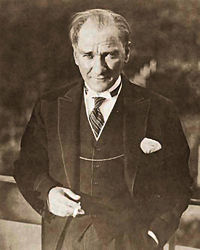 Mustafa Kemal Ataturk | 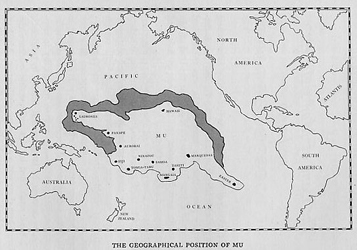 | 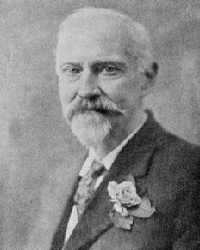 James Churchward |
For a long time I had been aware from speaking with people and emails that Mustafa Kemal Ataturk, the first President of the Republic of Turkey was a sincere believer in the theories of James Churchward and the common origin of man in the now sunken continent of Mu. For over a year I have been searching for information on the research that Ataturk undertook with regards to the 'Great Uighur Empire' as detailed by my great grandfather in the 'Children of Mu.' [Please note that this is an ongoing effort to research the sources of stories about the 'Great Uighur Empire' and is carried out on the 'Great Uighur Empire' mailing list, details of which can be found here: http://mail.my-mu.com/mailman/listinfo/gue_my-mu.com]
Well, finally I have been provided some clues.
Recently, a reader wrote to inform me that Ataturk had sent the historian, Tahsin Mayatepek to serve as the Turkish Ambassador to Mexico and that while he was there he was tasked with researching the similarities between the Turkic people and the Mayas. Also, Tahsin wrote five reports on the Turkic origins of Mayan civilization. This person has graciously agreed to translate these reports into English. As soon as I have obtained the English translations, they will be placed on the website under resources.
Also, I have also discovered the name of an author Sinan Meydan that has written books on the subject of Ataturk and his study of the lost continent of Mu. I have yet to contact him, but when I do, I'll pass along what I learn.
There are other theories competing with the theory of the Turkic roots of the Mayan civilization. For instance, there are several scholars and their works that postulate that Africa was the source of Mesoamerican civilization. These scholars point at the 'African features' of Olmec statues, introduced botanical evidence (the bottle gourd), and linguistic elements linking the African continent to Mesoamerica.
Another theory elucidates that Vedic influences in India served as the basis for culture and civilization for Mesoamerica and likewise it has been postulated that the Tamil people from Sri Lanka and southern India first brought their culture and civilization to Central America. Certain architectural features and linguistic content are used to provide the proof of these hypotheses.
Another theory insists that the Chinese were the true source of culture and civilizations for Mesoamerica. This ideology was also backed up with artifacts. Niven found what he termed a 'Chinaman' statue in his excavations in Mexico and an image was reproduced by James Churchward in his book "The Lost Continent of Mu Motherland of Man" (1926), "The Lost Continent of Mu"(1931.)
 | 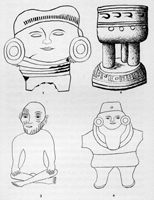 Relics from Niven's Lowest City 1. Egyptian head. 2. Ancient Grecian vase 3. A toy. 4. Little Chinaman |  |
Today's standard theory of the origin of the people inhabiting the Americas is that there was a migration through the land-bridge through the Bering Straits or in small boats along the Pacific coastline from Asia. Of course, as the standard hypothesis, these theories are rejected almost immediately in favor of some of the other lines of research indicating long oceanic voyages or from the lost continents of Atlantis, Mu, or Lemuria. Even the dates of the earliest arrivals are a contentious issue. Based on archaeological evidence available when the theories were first postulated, the human presence in the Americas was dated to 10,000 years ago. When finds were made that pushed back these dates, the original theory became a conspiracy and those that had stated it were hiding the truth.
The purpose of my research into the theories of James Churchward and the Lost Continent of Mu is to understand and interpret the evidence to reach a solid, defendable foundation of knowledge. Do artifacts from the Topper Site in South Carolina bear any resemblance to artifacts from the European Solutrean culture? Is there reason to believe Dr. Goodyear when he states that there are European influences in pre-Clovis sites in the Americas? Does the genetic evidence retrieved from the Windover site in eastern Florida indicate a heretofore unknown people? What about the age of some of the South American sites that predate any sites in North America, where did those folks come from? Does any of this mean that the European influences were derived from colonies of Atlantis before it sank or are these the remnants of the colonies of Mu?
There are still many questions to be answered and probably even more to be asked. The veil surrounding the theories researched by Ataturk regarding the Great Uighur Empire and the Turkic origin of mankind will hopefully be lifted soon and serve as a starting point for further understanding.
Lastly, let me state that I have the utmost respect for the final resting place for everyone that came before us. I understand the concern felt by some that the respect due them has not always been shown to the remains of Native Americans and I share their concern that disturbing their remains is against their wishes. However, I would be remiss if I did not mention that our knowledge of the people inhabiting the Americans is fragmented at best. One or more groups/tribes can trace their ancestry to a certain location for hundreds of years and while it is understandable that they do not wish for their ancestors to be dug up, the fact remains (i.e., the remains discovered at the Windover Bog site or the Kenewick Man), that the remains of some folks are not related to the people who were here when the European settlers arrived. With the laws on the books today, any research into finding out who some of the other peoples were is forbidden. Were more remains found today, archaeologists are not able to even test to discover whether or not they are related to the people known as 'native Americans.' Therefore, until something can be worked out to be able to research the peopling of the Americas, science takes a back seat to political correctness. My concern is that if someone does find the remains of colonists from Atlantis or Mu that date back ten or twelve thousand years, the find must be covered and everyone loses the knowledge which might tell us the truth, instead of the fragmented truth that is known today.
Jack Churchward
Clearwater, Florida